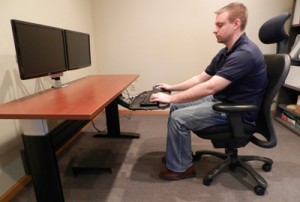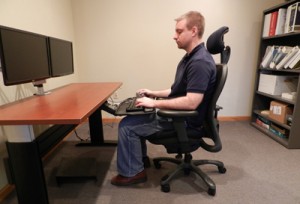The “Split Keyboard” is the most common form of ergonomic keyboard available on the market today. These mainly solve the problems related to wrist ulnar deviation (hand deformity, seen in chronic rheumatoid arthritis and lupus erythematosus, in which the swelling of the metacarpophalangeal joints causes the fingers to become displaced to the ulnar side).
There is no research available to prove conclusively that split keyboards can solve these problem. For most people a regular keyboard works well if they use itplaced in the proper position. For some people a split keyboard may be a better solution, it is really up to the preference of the individual. Whatever choice you make, make sure you are comfortable and follow the standard ergonomic guidelines.
The procedure of selection and arrangement a keyboard plays a vital role in decreasing ergonomic problems. When designing a computer workplace, you should remember certain vital factors like the height of the keyboard, its distance from you, and the usage.
Keyboard Guidelines
- Ensure that the keyboard is placed directly in front of you.
- Ensure that the elbows are close to your body and the shoulders are in relaxed position.
- Ensure that your wrists are straight and in -line with your forearms.
Placement – Height:
Probable Risks:
You tend to keep your shoulders, arm, and wrist in awkward positions if the keyboard, pointing devices, or working surfaces are placed too high or too.
Normally, your wrists bent up when the tray or desk is placed too low and you raise your shoulders to elevate your arms when the keyboards are placed too high. Such kind of awkward postures may lead to discomfort of the wrist, hand, and your shoulder, and could ultimately lead to RSI or Carpal Tunnel Syndrome.
Feasible Solutions
- To maintain proper seating, the height of the chair and the work surface need to be adjusted. Your elbows need to hang comfortably to the side of the body with the height almost same as the keyboard tray or desk. The shoulders need to be in relaxed position and ensure that your wrists do not bend up or down or to either side while you are using the Keyboard Ergonomics.
- Ensure that the thickness of your work surface is not more than 2 inches.
- Good adjustable trays with adjustable height and tilt giving enough space for leg and foot along with adequate space for other input devices like keyboard/mouse are available in the market if you find it difficult to adjust your work surface or your chair. While selecting a tray, ensure that it has all the mentioned features
- The vertical position of the keyboard should be maintained within the recommended range. Its tilt can be raised or lowered using the feet to maintain straight, neutral wrist postures while making slight changes in arm angles.
Placement – Distance:
A keyboard user is forced to assume awkward postures such as reaching with the arms, leaning forward with the torso, and extreme elbow angles if the keyboard or pointer/mouse is placed too close or too far away from him. Studies have shown that such awkward postures generally lead to ergonomic disorders of the elbows, shoulders, hands, and wrists.





